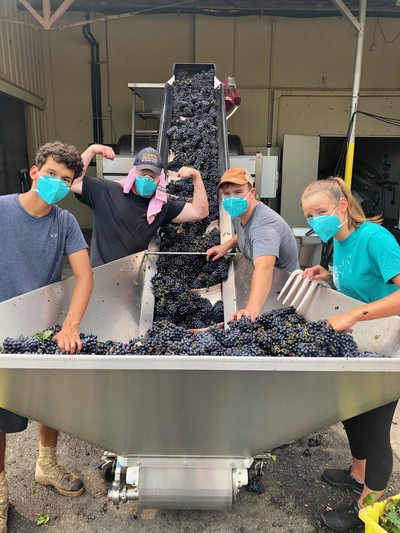News
Welcome to the St. Amant blog and news page. Here you will find the latest news, event activites, and other useful information to better enjoy St. Amant wines.
A Fresh Look
Each wine, each vintage, each up, each down is the story of our life. For over 50 years we’ve been on this journey they call wine. The journey has become our story…a story of hardship and success, a story of hard work and craft, a story of family, farming, and friends. These stories are who we are, what we do, and why we do it.
Over the past two years, we’ve been reflecting on how best to tell our story. How best to honor our past, my parents, and all those that have helped us along the way. And how best to show the intention, curiosity and craft that has become St. Amant.
To bring our stories to life, we took a holistic view of who we are, the wines we make, and why we do it. We stopped. Stepped back. Took a break from just getting to the next day, to the next chore, and the next bottling. We thought with intent about what we wanted to say.
Beginning with our 2022 wines, each vintage will feature an original piece of art that tells a story. The 2022 vintage features a scraperboard illustration of my dad’s work boots by Irish artist Brian Gallagher. All the 2022 wines will feature my dad’s boots, and each subsequent vintage will have a new original piece of art that tells a story. There’s more to come, but for now enjoy my dad’s boots, and our 2022 wines.


My dad’s fashion consisted of Levi’s 501 jeans, a shirt, and laced-up work boots. He grew up on a dairy farm in the Central Valley as the oldest of five children. Life was tough. He milked cows by hand, twice a day, every day. When I was a child, he worked two jobs, farming on the weekends. To spend time with him, we would bring lunch, play in the irrigation ditches, and spend the afternoon at the vineyard.
The mixed smell of sulfur dust, dirt and diesel was my dad. I can smell it now. His boots were well worn. Not hipster boots, or branded boots. Just basic brown leather boots. He wore them to the holes in the bottoms were unbearable. His days were long and hard, and his boots showed it. His boots led him down the road less traveled. It was his path, and our wines, and our life are better for it!

Why We Do It
My dad was the rebel, the independent thinker, the one that went left when everyone else went right. He lived outside the box and had zero patience for fools, charlatans, and salesmen. My mom is the rock, the rudder in the storm, the engine that keeps on going. The one that is always there.

In 1974 they harvested our first crop of grapes from our ranch in Amador County. Those first grapes were bottled as a vineyard-designated Zinfandel Rose by Concanon Vineyards. That wine and that experience launched our family on a 50-year journey into the world of wine. It has been an adventure, a road less traveled, filled with potholes, twists, and turns.
Whether it was frost, fires and floods, or rattlesnake bites, severed fingers and smashed knees, the wine and grape business has been painful. Lawsuits, broken contracts, and dead-beat wineries, distributors, and restaurants were at every turn. We’ve had stolen wines, and stolen vines. Been bit by black widows, drove redwood stakes through the arm, and busted our bladder. Beavers flooded the ranch, and phylloxera killed the vineyard. If a mistake could be made, we made it. If a problem could happen, it happened to us.

When I was 2 months old my parents bought our ranch, at 4 we harvested our first grapes, at 8 they partnered on a fine wine shop, at 9 I was stealing sips of Chateau d’Yquem from my mom’s lap, at 10 I was foot stomping our first port in the front yard, at 11 picking grapes for our first Sauvignon Blanc, at 12 leaf-pulling and cluster thinning, at 13 attending my first tasting event at the Amador County fairgrounds. At 36, Dad passed, and three days later, I was crushing grapes. At 54, I’m still doing it! At 82, mom is still at it.
Why do we do it? It was not a lifestyle choice, second home, or the need to have our name on a bottle of wine. Our story is one borne of necessity. At first, we did it to get to the next day. We made wine when the grapes wouldn’t sell. We sold wine to pay the bills. Quitting was not an option. As time passed, our why evolved. We were doing something special; we were doing something different, and we were part of a bigger story. We were lifting our community up and showing them a different way.
We were at the forefront of planting Portuguese and Spanish varieties in California. We were at the leading edge of artisan winemaking in Lodi, showing growers a different path, and giving our community a sense of place. We’ve done this through an unwavering multi-decade commitment to our land, to our craft, and to our vision. And along the way, we’ve made wines that make people happy. Wines that connect them with a time and place and connect them with each other and with us.
The journey is not over. In many ways, we are still at the beginning. We have big plans, new ideas, and feel our best wines lie ahead. We have lifelong customers that have supported our journey, and loyal dedicated employees who help make it all happen. Thank you for your support, and stay tuned, we have exciting news coming!
Cheers!
Stuart Spencer

Why Ports and Portuguese Varieties
50 years ago, before today’s bearded beanie-wearing hipster winemakers were even a glimmer in their boomer mom’s eyes, my father chose a different path in California viticulture. His road was not defined by his outfit1, or schooling, but by his innate curiosity, entrepreneurial spirit, and love of farming. He had a simple vision. To grow world-class port-styled wines in his Amador County vineyard. This was not something he stumbled upon by accident, but an intentional effort of purpose. Some would call him crazy, others foolish, but he rarely cared what other’s thought, and instead chose his own path.
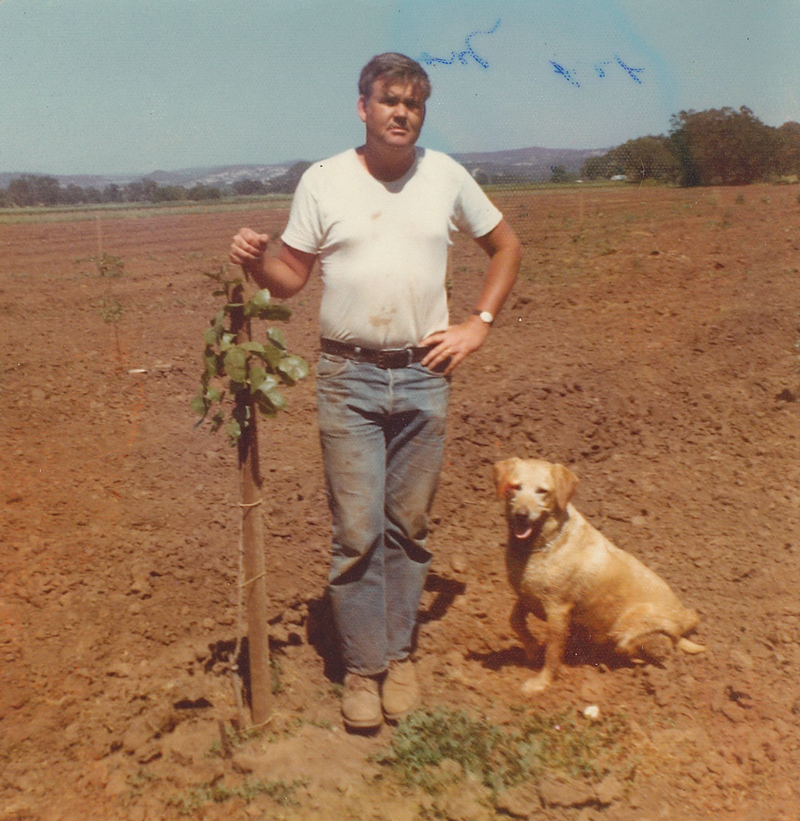
When I was two months old, my parents purchased our property in Amador County. They were told grapes would grow well so they planted Zinfandel and began selling the winegrapes. Knowing little about wine, but ever curious, my dad soon found himself partnering with four doctors, and opening a fine wine shop. The endeavor attracted like-minded wine enthusiasts and soon they were regularly tasting the world’s finest wines. This was the 1970’s and the US wine culture was in its infancy.
My dad fell in love with Portuguese Ports, and we were soon making our own homemade batch from Zinfandel grapes - foot stomping them in a garbage can in our front yard. It was good but didn’t taste anything like the Portuguese. Nor did any of the commercial ones being made in California at the time. His curiosity led him to UC Davis where he found a handful of indigenous Portuguese varieties available as bud wood.
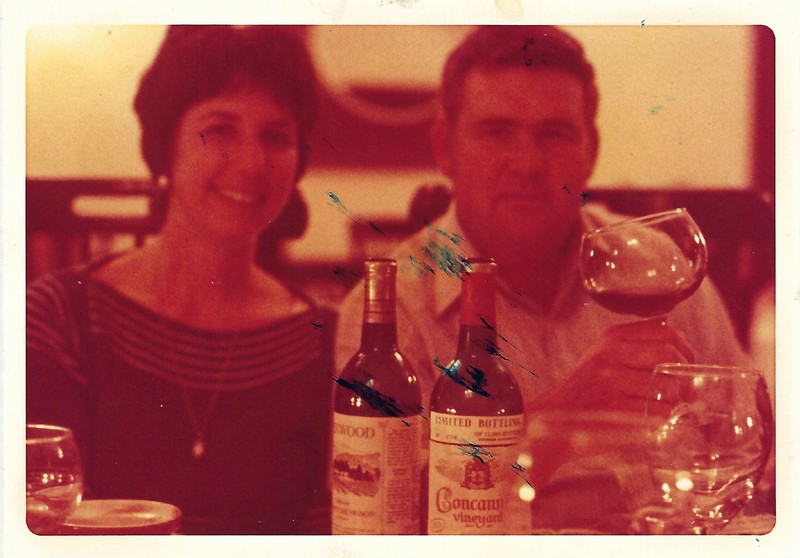
He soon grafted five rows of Zinfandel to Touriga, Bastardo, Tinta Cao, Alvarelhao, and Souzao.2 Those first Portuguese grapes ripened in the fall of 1981 and were sold to a passionate winemaker who shortly after harvest filed bankruptcy. They had purchased our entire crop and failed to pay the bill. This came on the heels of another wine corporation breaking our contract right before harvest. Threatened with survival, my dad reclaimed the young port, and bootlegged it to a friend’s winery in the foothills.
He concluded he didn’t need anyone else’s help going broke, that he was quite capable of it himself, but by bottling the young wine, at least he could control his destiny. That was 1981, and that wine became our first vintage port.
It was a hit, and we soon found our ports being sold from the top restaurants in New York to the leading retailers in Los Angeles. The wines were good, really good, and the varieties seemed to find a natural affinity in our foothill vineyard. The dry hot days, cold nights, and sandy loam created ideal conditions resulting in vibrant aromatic well-structured wines. Wines with staying power and a sense of place.
My dad’s guiding principles were equally simple. First, grow the right grapes in the right spot. Second, as a small winegrower, you must find your niche, and be good at it. Third, farming and winemaking is a natural process, and you need to work with nature to grow the healthiest grapes and make the most interesting wines. And finally, no BS. There was a lot of horseshit in wine world, and he was going to speak the truth.
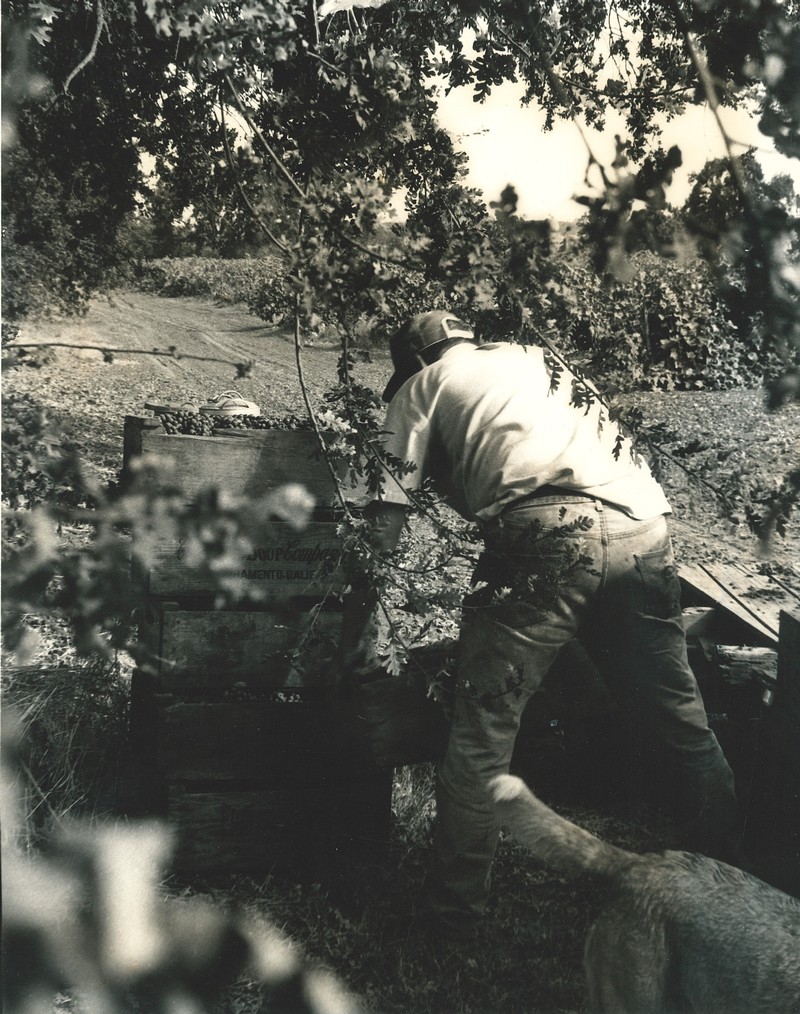
Throughout the 80’s and 90’s his vision grew and soon we were making dry table wines from Portuguese varieties, white ports, tawny ports, and others. We expanded our acreage, redeveloped our vineyard, changed our trellising, and planted more varieties. Business was not easy, but we survived and made better wines.
This was my world as a child, teenager, and young adult. I was “free” labor spending countless hours in the vineyard and cellar and inheriting my dad’s sense of curiosity and guiding principles.
Today, we like living outside-of-the box, and we are committed to building on my father’s legacy. We have plans. Really interesting plans, and some exciting new wines to share with you in the months ahead.
Stay tuned! You will not want to miss this!
Footnotes
- My dad had basically one outfit. 501 Levi’s, collared shirt, and work boots.
- The Alvarelhao in California would later be identified as Touriga Nacional. They weren’t sure what the “Touriga” was we received, but I believe it to be a different clone of Touriga Nacional. And Bastardo is the Portuguese synonym for Trousseau.
Harvest 2022
The wine business is not easy! It’s a capital-intensive business that is subject to the whims of Mother Nature. Its products (wines) have a long lead time requiring vintners to carry a lot of inventory. In some cases, you have produced 2-3 vintages of a new wine before you’ve even sold a single bottle and have any sense of whether the customer likes it. And there are plenty of charlatans circling the industry whose best skill is their inability to pay their bills.
This past year has reminded us of how challenging the business can be. On April 12 we saw the worst frost in 20 years in our Amador County vineyard leaving some varieties with a 50-70% loss (Verdelho and Tempranillo). Farming a “frosted” vineyard required a significant investment of time, labor, and money, much more than normal, to get a small and somewhat irregular crop. The spring freeze was balanced out by an epic heat wave in early September that saw record temperatures across California. This heat left afternoon-facing exposed fruit (not covered by leaves) sun-bleached and shriveled, and many vines struggling to recover. Our team worked frantically to get fruit picked and suffered through intense heat on the crush pad (the concrete was 140 degrees).
To complement Mother Nature, we have seen unprecedented cost increases as inflation has rolled through the economy. Bottles are up 24% from last year, corks 15%, tin capsules 35%, labels 17%, sulfur dust 40%, diesel and gas 40%, utilities 30%. The only thing to come in cheaper has been French Oak barrels due to the strong dollar and weak Euro. But any savings, has been offset by freight/ocean surcharges in getting us the barrels.
And despite these challenges we continue to invest and focus on doing better…making better wines and providing better customer experiences. We are striving to go deeper with each wine we make and each variety we farm. Each step, each process, each moment is given thoughtful intent with a holistic view of the vineyard and the final wine we strive to craft. This clearly is not always easy, but we persist, and I fully believe we are making some of our best wines.
And thankfully we are supported by you, a loyal customer base that appreciates and supports our efforts to craft delicious wines. Your fall shipment includes four wines that represents the journey we are on to make distinct, delicious wines that speak of a time, a people, and a place.
Enjoy!
Stuart Spencer
2000 Tawny Port - Madison's Blend
The simple story is this is an incredibly special wine. Made by my father and myself shortly after my oldest daughter was born. The wine was left untouched in barrels for 21 years to slowly mature and concentrate flavors and bottled this past September to commemorate her birth. It is a one-of-a-kind wine that celebrates my daughter, my father, our vineyard, and the shared history we all enjoy.
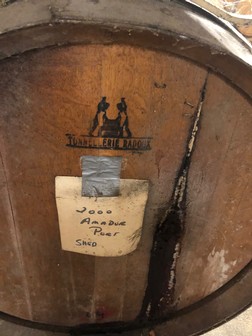
The longer story begins in the late 1970’s when my father fell in love with Portuguese Port wines and decided to graft over five traditional Douro Valley Portuguese grape varieties into our vineyard in Amador County in 1980. The goal was to produce exceptional quality vintage port-styled wines in California soils. Over the years the vision grew to include table wines and extended barrel-aged tawny ports from these exotic varieties.
Our first Tawny Port was bottled in 2000 and was made exclusively from the 1989 vintage. It was a 50/50 blend of Bastardo Port and our traditional five variety port. My dad kept a barrel of the Bastardo Port separate as an experiment. His thought was to produce a Madeira-styled wine since Bastardo was grown on the Portuguese island of Madeira before phylloxera (root louse) swept through the island killing off the vineyards and forcing growers to replant on phylloxera-resistant rootstock. Bastardo wasn’t replanted because it was likely a low-yielding variety and a real “bastard” to grow.
My father and I took the experiment one step further in the mid-1990’s and began heating our barrel of Bastardo. Traditional Madeira is aged in naturally warm cellars over an extended period allowing the wine to gradually “bake” and oxidize over many years producing incredibly complex and indestructible wines. The results of our experiment were stunning – Bastardo responded exceptionally well to this process evolving from an odd strawberry earthy flavored wine into a stunningly complex nutty vibrant wine.
Our original vineyard was planted n 1972 on its own-roots (Zinfandel), and by the early 1990’s was showing extensive signs of phylloxera damage. We ultimately pulled the entire vineyard out in 1995 and began a deliberate process of replanting our vineyard with updated trellising, varietal selection, drip irrigation, and rootstocks with goal of producing exceptional table and port-styled wines from Portuguese varieties. Bastardo, along with Touriga Nacional, Tinta Cao, Souzao, Tinta Roriz (Tempranillo), Verdelho, and Alvarelhao were all selected. Alvarelhao was later identified through DNA testing to be a clone of Touriga Nacional.
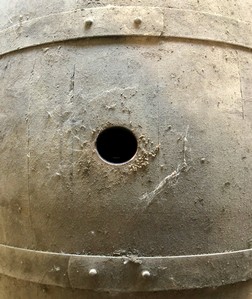 The first grapes off our new planting became our 1999 Vintage Port (black label) and was bottled in the summer of 2001. The 2000 vintage was challenging, and we ultimately decided not to bottle a vintage-styled port but elected to continue barrel aging the wine to produce a Late Bottled Vintage style wine or a Tawny Port.
The first grapes off our new planting became our 1999 Vintage Port (black label) and was bottled in the summer of 2001. The 2000 vintage was challenging, and we ultimately decided not to bottle a vintage-styled port but elected to continue barrel aging the wine to produce a Late Bottled Vintage style wine or a Tawny Port.
Traditionally, Vintage Ports make incredible birth year wines, and are often purchased to be enjoyed when the child turns twenty-one. They are not for the child’s benefit, but for the aggravation the child inflicts on the parent over the course of 21 years. I decided to take the process one step further and elected to set aside 6 barrels of out 2000 vintage port and age the wines in barrels until she turned 21.
This past September we bottled our 2000 vintage port aptly named “Madison’s Blend” after my oldest daughter that was born on May 23, 2000. It is unlike any wine we’ve produced or anyone else is doing in California. Not only were the barrels baked at one point, but they were never racked or topped. Each barrel was essentially half full and had been hidden deep within the cellar to slowly oxidize and evolve over 21 years. The alcohol content rose from 18% to 21% as the water evaporated and the wine concentrated. It’s an indestructible wine boasting a deep amber hue and stunning aromas that fill the room with a decadent aftertaste that lingers on the palate for minutes.
It's one-of-a-kind! Just like my father and my daughter.
Sincerely,
Stuart Spencer
PS – Bastardo is the Portuguese synonym for Trousseau, a variety native to the Jura region of France. It’s unclear how it found its way to Portugal and Madeira. We began bottling a bottling a dry Trousseau in 2012.
PPS – We produce 2-4 barrels of Bastardo Port each vintage. They are never racked, topped or sulphured and form the base of our Tawny Ports.
PPPS – I didn’t bottle all the 2000 Madison’s Blend but kept back approximately 90 gallons for a future bottling. Maybe when she gets married.
|
Harvest 2021 Update
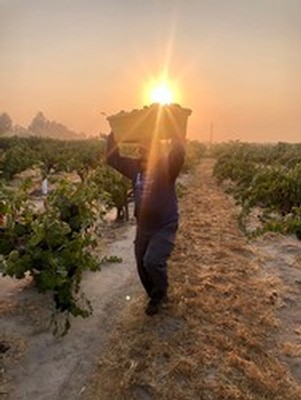 One of the less discussed and less romanticized aspects of crafting distinctive wine is harvest logistics. Logistics is a term generally relegated to the manufacturing sector and supply chain when figuring out to how to move products most efficiently and effectively from point A to point B. And for wineries, once all the fluff and romance are removed, we are not much more than a fairly messy manufacturer.
One of the less discussed and less romanticized aspects of crafting distinctive wine is harvest logistics. Logistics is a term generally relegated to the manufacturing sector and supply chain when figuring out to how to move products most efficiently and effectively from point A to point B. And for wineries, once all the fluff and romance are removed, we are not much more than a fairly messy manufacturer.
I have often stated that there are no secrets to making good wine, it just comes down to basic execution, and managing harvest logistics is core to crafting delicious St.Amant wines. Harvest logistics is a million micro-decisions and actions over the course of several months that result in consistently good wines. And if you are producing more than a few barrels of wine, it requires a team of talented hard-working individuals that work in harmony to get the job done. And finding your harvest rhythm is key to making the logistics all work.
And when you’re dealing with Mother Nature, and people, the best laid plans can all go to hell. And they frequently do! This year was no different. Extended heat throughout August and September led to many of our varieties ripening simultaneously. We literally picked Alicante Bouschet and Cabernet Sauvignon a month earlier than 2020. The net result is that tank space for fermenting and pressing were at a premium. We essentially got plugged up with grapes. And this was compounded by the fact that our yields were up, which is a good thing after the dismal yields we saw last year.
I also tend to complicate things by splitting up varieties and vineyards into multiple small lots. The goal is to build complexity, experiment, and produce better more interesting wines, but the logistics become increasingly complex as we strive to keep the lots separate. “Normally” harvest reaches a crescendo around the first week of October. This is the point where you are picking, crushing, pressing, and barreling down wines simultaneously while worrying about potential storms. This year we peaked around Labor Day, and it never really slowed down.
Furthermore, labor and trucking challenges made this year’s logistics even more challenging. We did buy a new flatbed truck to help with the smaller picks but ended up hauling most of our grapes back to the winery. Nathan became quite the proficient truck driver. When all was said and done, we ended up crushing 207 tons spread out over 43 distinct lots and 12 different varieties. And through yesterday, we’ve filled 418 barrels with 2021 wines.
Of course, the ultimate question, did all the organized chaos of harvest produce good wines. The simple answer is yes. Although there is still a long way to go, my hunch is that there will be a few exceptional wines from this vintage. Across the board, they all had higher levels of natural acidity and good concentration and depth of flavor. We saw very little disease or pest pressure, and most of the grapes arriving at the winery looked beautiful. As always, we strive to make the best wine year in and year out, and focused execution on harvest logistics allows us to do more and make better wines with each vintage.
Harvest 2020
Harvest is always an adventure, and 2020 did not disappoint. Despite the challenges of COVID and the wildfires that ravaged northern California this late summer, we produced some truly delicious wines. In all honesty, it's too early to really tell, but initial assessments look very promising. Harvest got off to a wild start on August 18th with our Verdelho and was quickly followed by Bastardo/Trousseau, Touriga Nacional Rose, and Zinfandel. We picked almost all our Zinfandel in August – more than any previous year, and then quickly jumped into our Tempranillo.
There were a few key factors that led to the early and rapid pace to this year’s harvest. First, the crop across all our vineyards was incredibly light. Our St. Amant vineyard in Amador County was off 30% from last year and averaged 2.86 tons/acre across the entire vineyard. These are not money-making yields, but the quality and concentration in some of the finished wines is incredible. Unfortunately, there will not be a lot of wine to sell from 2020.
Secondly, we had three heat waves throughout harvest that accelerated ripening. The mid-August heat wave that saw a week of triple digit temperatures across California quickly ripened our early varieties. This was particularly impactful due to the light crop. Our Mohr-Fry Ranch and Marian’s Vineyard Zinfandel saw brix jump nearly 4 degrees in one week. Those old vineyards also only yielded about 2.5 tons/acre. As resilient as these old vines might be, I’ve found them particularly susceptible to harvest stress (heat), and typically don’t respond as quickly to that stress. These conditions can lead to excessive dehydration and disease (rot). And was one of the reasons we moved quickly to get our grapes harvested this year, which resulted in lighter alcohol and a fresher style in our 2020 Zins.
Finally, the wildfires, smoke and extended weeks of poor air quality had a profound impact on much of California. Fortunately, Lodi and the Sierra Foothills were far enough removed from a direct impact that it appears to have had a minimal impact on our wines. This is new territory for much of California wine and the science on smoke in vineyards is not very clear, and there is still much to learn. And while it created a great deal of stress throughout harvest, we feel grateful that our vineyards and wines were not impacted. Our heart to goes out to our industry colleagues who weren’t so lucky – who were unable to harvest their vineyards or in some cases saw their wineries and homes burn.
As much as we like to make analogies to cooking and winemaking, they can be profoundly different. 2020 once again reminded us how little control we have over Mother Nature, and that one of the keys to success is following your intuition and gut when making wines. Reading the vineyard, the season, and the unfinished wines is often difficult to define, but key to consistently making compelling wines. And working with the same vineyards, year after year, decade after decade, gives us the wisdom to guide those wines.
We look forward to sharing the 2020 wines in the years to come.
COVID-19: Protecting our Staff and Customers
Over the past few weeks, we have recieved a number of questions about what we are doing to help protect customers and staff from COVID. Below we've compiled a list of our current practices to help limit the spread of COVID-19. While no solution is perfect, we continue to rely on the advice from local health authorities and the CDC for best practices. As this is an evolving situation, we will continue to modify the list below to reflect new recomendations and mandates.
Protecting our Customers
- We have increased the frequency of cleaning and sanitizing restrooms,and other high traffic areas
- We are offering contact free pickup for all orders
- We have eliminated signatures for all orders
Protecting our Staff
- We are offering an additional 2-weeks of paid leave for staff
- Staff are screened at the start of each day to ensure they do not have a fever or other symptoms
- Staff are encouraged to maintain social distancing of 6ft. throughout the workday
If you have any questions regarding our sanitation or pickup procedures, please email: info@stamantwine.com.
Spring in the Vineyard
There is something reasurring about spending time in the vineyard. We may all be sheltering in place, hunkred down, with most of the world shut down, but the vines are starting to grow. They will grow regardless of what is happening in the world. Nature follows its own course, and we are along for the ride.
The other day I took the time to travel up to our vineyard in Amador County. My parents purchased the property in 1970 when I was 6 weeks old. At the time, my dad just wanted to get back into farming, and had no plans to start a winery. Winegrapes were recommended, and in 1972 they planted their first vines. Own-rooted Zinfandel. Those vines ultimaely succombed to phyloxera, but that is another story, for another day. Today, I just wanted to see how things looked, check on the vineyard, and start thinking about the 2020 wines.
It's often said that great wines are made in the vineyard. Winemakers can take great grapes and make mediocre or brilliant wine, but mediocre grapes will at best lead to average wine. We strive to do better, and the shots below will give you a glimpse as we start the process of crafting our 2020 wines.
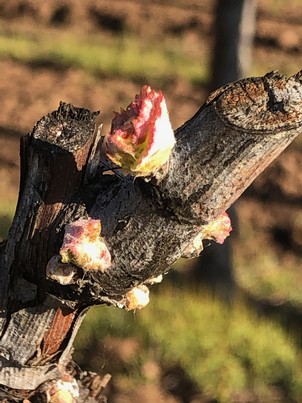
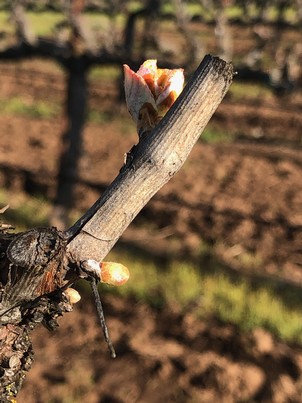
The left photo is Trousseau (Bastardo) and the right photo is Touriga Nacional. These vines were pruned back in December. A few things to note -
- Trousseau - notice there are at least 4 or 5 buds pushing out leaves. We will come back in a couple weeks to "shoot thin", removing three or four of those shoots, and leaving the most vigorous and well-postioned ones. Trosseau is notorious for pushing out a lot of shoots. This can lead to problems later in the season with over-cropping, clusters touching each other, and excesive shading around the fruit. Trousseau also rots easily so we want to avoid those conditions. We will sometimes have to shoot thin this variety twice because it will continue pushing out late shoots. This is an expensive process, but I believe setting up the vine correctly early on gives us the best chance to make delicious wine later.
- Touriga Nacional - this variety is one of the last varieites we pick every year, usually around the third to fourth week of October for our reds and port-styled wines. And that's aiming for 24-25 brix. It's a late ripener and produces a light to moderate crop. Yet it is one of the first varieties to push in our vineyard in the spring. This allows for an extended growing season. I believe Touriga Nacional is one of the most versatitle and successful varieties we grow in our vineyard. The grapes are used for a rose, table wine, and as a key component in our port-styled wines. Although it has a long growng season relative to the other varieties, the grapes are usually beautiful at harvest.
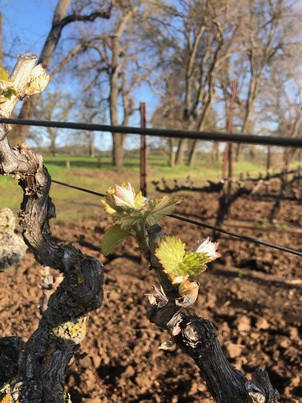
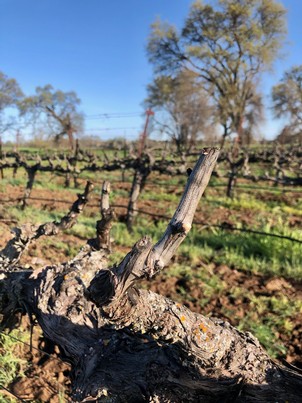
The left photo is Tinta Cao, and the right photo is our oldest block to Tempranillo. Both of these were pruned back in December as well. A few things to note about each -
- Tinta Cao - we've been growing this variety since 1980. We only have about 1 acre that is used exclusively for our port-styled wines. Years ago, my dad used it as a component in our "Tres Cachos" which was a three variety blend of our Portuguese varieties. Personally, I've never been that fond of it on its own. As you can see, it pushes out early, and usually ripens mid-September. It's an extremely vigorous variety and the vine just wants to keep growing all season. The trick with this variety is to slow that down and open up the canopy. I like to shoot thin it later hoping some of the younger shoots absorb some of the vigor and slow the vine down.
- Tempranillo - this is our oldest block of Tempranillo planted in 1998. It's about 3.5 acres and usually all of it ends up in our St.Amant Tempranillo. You will notice on these vines that the leaves have not pushed out yet. The buds were just starting to swell, and we will probably see leaves in about 5-7 days after this picture was taken. Tempranillo is an early ripening variety and we have picked this block as early as late August. It is also a vigorous variety that likes to grow in our vineyard. Managing the growth is key to producing quality wines.
Each variety and each season continue to pose different challenges, and require us to be vigilant in order to produce the best wines come fall. I'm convinced that the early season work of shoot thining and managing vigor are essential to producing quality wines, and leave us better prepared for any challenges that arrive in late summer early fall. Now, my biggest concern is a frost. Historically, we've had a bad frost as late as April 28, and we really don't relax until we get into early May.
Mohr-Fry Ranch - 2020 Medal Winers
One of the lessons I learned from working with my dad is to do business with people you like. To work with those that are easy to work with and make you better at what you do. This may sound simple, but in reality, you end up having to deal with a lot of people, and some of them can be a real pain-in-the-ass. Both customers and vendors. The key is the relationship, and that is never more apparent than in our 24 years of doing business with Jerry & Bruce Fry.
When we moved our winery to Lodi in 1996, our own vineyard was dying of phyloxera, and we had no grapes to make wine. My father worked out a deal with the Lodi Winegrape Commission – if a grower brought us 2 tons of grapes, we would make the wine, and give them 25 cases, and keep the balance for ourselves. At this point in time, there were only a handful of Lodi wineries, and very few “Lodi” labeled wines in the market. The vast majority of Lodi grapes were being blended away in big tanks at large wineries, and growers really had no sense how the wine from their vineyards tasted.
Jerry Fry showed up with 7 tons of beautiful Old Vine Zinfandel grapes. My father didn’t know what to do. We didn’t have the money to pay for the grapes, and we had no idea how the wine would turn out. Jerry told him not to worry about it, that we would work it out later. We ended up bottling 450 cases of that first vintage. It won a bunch of awards, sold out quickly, and has since grown to be our most popular wine.
The above story epitomizes our relationship with Mohr-Fry Ranch. To this day, we don’t have a contract, but a relationship sealed with a handshake, and glass of Zinfandel. It’s this type of partnership that helps us succeed, propels Lodi to new heights, and makes business fun. That commitment to quality shown through especially well this year, with a number of big awards for our Mohr-Fry Ranch Petite Sirah, Old Vine Zinfandel and Alicante Bouschet!
2018 Mohr-Fry Ranch Alicante Bouschet
Best of Class, San Francisco Chronicle Wine Competition
2017 Mohr-Fry Ranch Petite Sirah
Double Gold, Sunset Magazine International Wine Competition
Gold, Los Angeles International Wine Competition
93 Points, California State Fair Wine Competition
2018 Mohr-Fry Ranch Old Vine Zinfandel
Gold, San Francisco Chronicle Wine Competition
